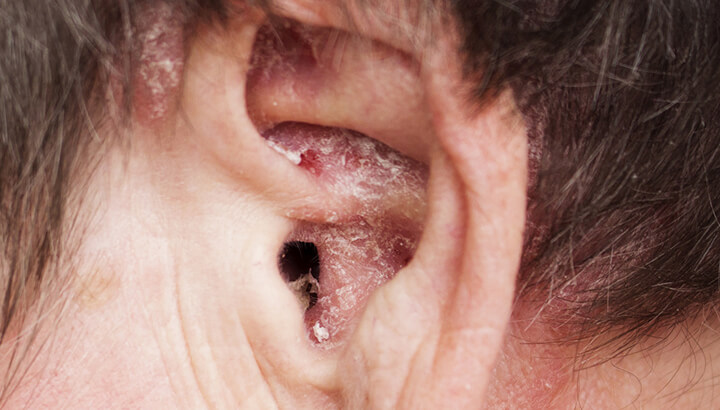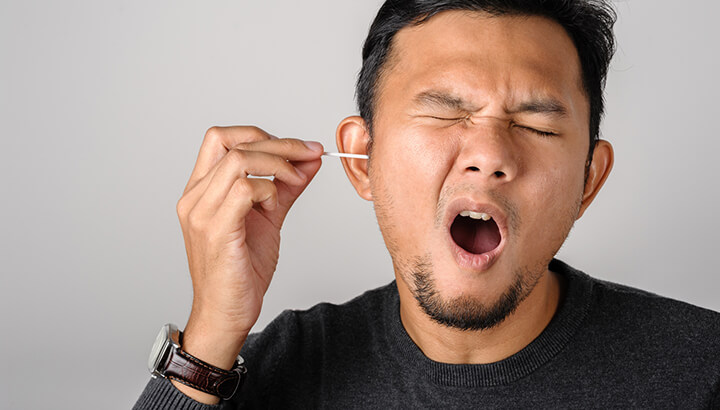
No one wants to talk about earwax, but it’s a gross part of life that’s worthy of conversation. So, what exactly is earwax, and why does it accumulate in your ear? Can you have too much of it? More importantly, what does the color and consistency of earwax say about your health? Maybe it’s time you looked a little more closely at your earwax for signs that suggest a trip to the doctor.
What’s the deal with earwax?
Yes, even earwax has a job to do. It helps keep dirt and bacteria from getting inside your ear canal. It’s also a self-cleaning agent, with protective, lubricating and antibacterial properties. But unless you have an earwax blockage, experts agree, it’s best to leave your earwax alone.
In fact, earwax buildup normally finds its way out of the ear canal thanks to chewing and other jaw movements. It carries out dirt, dust and other small particles that naturally find their way into your ear. Eventually, dried-up clumps of the gunk fall out of the ear opening — yuck.
Avoid cotton swabs
But, too much poking around in there with cotton swabs or other implements and you might just create an earwax blockage — a condition called cerumen impaction — that causes more harm than good.
But, alas, sometimes you just need to clean up your act, so to speak, and throw all caution to the wind. Particularly if you are an older adult, naturally more prone to earwax buildup than a younger person. But instead of inserting anything inside your ear canal, The American Academy of Otolaryngology suggests washing the external ear with a cloth. Alternately, you can also use home wax-softening treatments.
You can also use mineral oil, baby oil, glycerin or commercial drops in the ear. Hydrogen peroxide will also help remove wax buildup. Now let’s dig a little deeper into that earwax and see what the color and texture says about your health.
Watery earwax
Watery earwax is usually a sign of excess sweat in your ears — nothing to worry about. Unless of course, earwax is dripping onto your pillow at night or leaving crusty remnants on your ears, then you may want to consult a doctor in case of a potential eardrum rupture suggests The New York Times Health Guide.
Discharge may also be white or yellow and slightly bloody. A ruptured eardrum may be caused by a middle ear infection or a cotton swab pushed a little too far into the ear.
Flakey and dry earwax

Flakey and dry earwax may actually be eczema, suggests Healthline. Eczema causes a buildup of skin cells in the ears. And if it’s accompanied by soreness, it could also be a sign of psoriasis.
But it’s important to note that if you are of Asian descent, dry earwax may come naturally. Research in the journal Nature Genetics found that most people of Asian descent have dry earwax, while people of African or European descent have sticky or “wet” wax. This is due to a genetic adaptation to the climates in which our ancestors evolved suggests the study.
Stinky smelling earwax
Earwax can have an odor. It consists, after all, of oils produced by the ear canal, dead skin cells, trapped dust and dirt, and even small insects! But it should not be so stinky and foul-smelling that you or anyone else notices.
One of the most common causes of foul-smelling earwax is an infection of either the external ear canal or the middle ear, according to health24. With infection may come smelly pus. And, depending on where the infection occurs, the discharge may be yellow to green in color.
Itchy earwax

Itchy ears are very common. But for some, the problem is so persistent that he or she even sticks objects into the ears for relief, ultimately causing trauma to the ear canal. There are some common causes for itchy ears, one simply being a nervous habit, suggests the department of otorhinolaryngology at the University of Texas.
Other causes may include a fungal infection or the beginning of an infection, skin diseases such as psoriasis or dermatitis, and allergies. But often, people will aggravate the problem further by using sharp things like bobby-pins or toothpicks to scratch the ear. This causes abrasions in the ear, and any break in the skin can allow bacteria to enter, thus, infecting the ear.
Thick, dry and darker-than-usual earwax
If you notice your earwax feels thicker, drier or is a little darker than normal, that, my friend, could be a sign of general aging. As we age, the outer part of the ear canal thins and earwax gets drier and stickier. But the problem is, some seniors let earwax build up — mostly men — so much that their hearing becomes obstructed, suggests the U.S. National Library of Medicine.
Furthermore, dead skin continues to build up non-stop. And, since the earwax is dry, the ear’s ability to lubricate and clean itself is less effective.
Remember, a little gentle cleaning with a warm soapy cloth is all you need to keep your ears clean. Pushing cotton swabs into your ear canal may cause more harm than good. Normal earwax ranges from light orange to dark brown and may even have a slight odor. But if it’s green, white or black, that suggests an infection, and you should see a doctor.
— Katherine Marko

